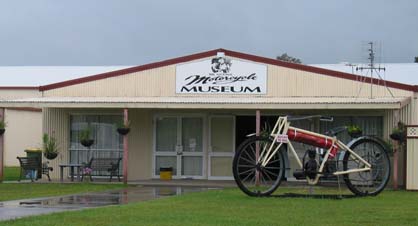
The rains have been following us for the past two weeks - ever since we left Narrabri in Queensland with its sweltering heat in fact. With some forethought, we'd marked on the gps the exit for Toronto (the one in NSW, not Ontario but nevertheless named after Yorktown-Hogtown-Toronto-in-Canada-whatever). Quickly dashed into Toronto and stocked up at the bottleshop (aka liquor store), the butcher and the baker and then to Freeman's Waterhole and on to Rosco www.roscoclub.org where we thought we might stop off for a couple of days. Rosco (the acronym is for Red Ochre Bay Swimming Club - and don't ask about the 'B' or the 'O') is surely one of our favourite places in Oz. We stayed here for over a week, enjoying every minute of it and meeting many old and many new friends. Gertie II sat comfortably down just where Gertie I had done three years before
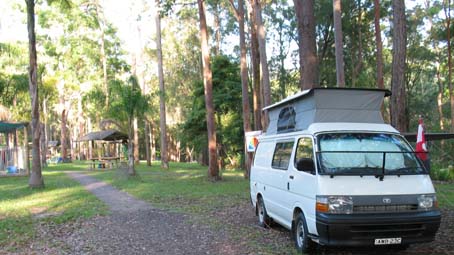
and for the next few days we got back into the usual laid-back way of life......never moved out of the club grounds except for the occasional foray back to Toronto for food and more importantly, drink. Yes, the daily 'Happy Hour' is the greatest of the three great gifts Australia has bestowed upon the world. The other two are - a place to put all of the world's flies - and (not unconnected with that) the cheery Australian wave.....Here's the locale of many of those Happy Hours, under the trees beside the Rosco swimming pool - that bottle is empty, by the way.
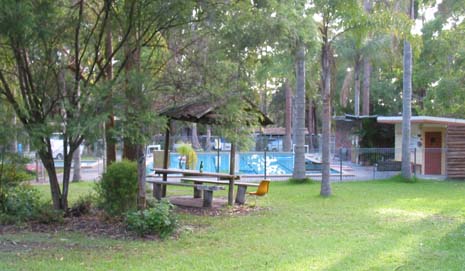
Sometimes one of the resident iguanas would take a stroll through, looking for handouts. The more frequent visitors, but at night only, were the opossums who got into the open-air kitchen whenever they could and whose favourite activity seemed to be taking baths in the deep-fat fryer. Cold baths only. Open-air is a bit of a misnomer - the kitchen is only truly open-air when the door's accidentally left open. You would have no trouble feeding three or four hundred visitors from this kitchen - but that's our coffee-pot on the right..
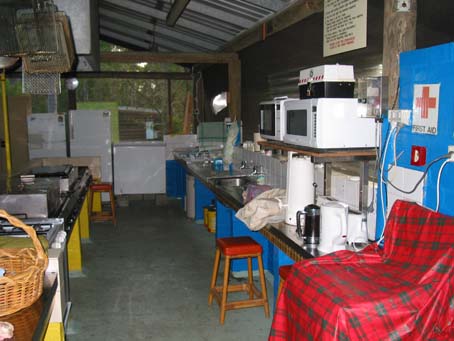
Thanks to all at Rosco and we'll be back in April we expect.
Now we had to strike across the country, westward toward Canberra, en route for the Australian Alps at the NSW/VIC border and first we had to escape the clutches of Sydney town because we still had to travel #1 southward for a few hundred km. You can't easily avoid touching on Sydney as you head down this coast, but we did our best to keep away from the city. Trouble is, there's no real bypass around the place and we invariably get snagged in city roads and exitless freeways. Eventually we extricated ourselves, managed to locate highway #31 rather than the much faster tollroad and so had a much more scenic journey toward Canberra. We had arranged to stop for a short time at the ACT Nudist Club a few km. N. of Canberra, just within the Australian Capital Territory itself. We did spend one day in Canberra later on (a full appreciation of this city would take weeks if not months) just to visit the Science and Tech. centre there. This would be a wonderful place to take your kids, even though it's a bit short on hard science. Our favourite things were the simulated roller-coaster ride (next best thing to Brave New World's Feelies) and the Free Fall (gulp) into a parabolic scoop.
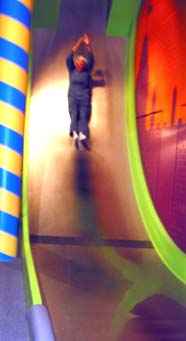
Note the (mandatory) Space Suit and the (mandatory) shoelessness.
We had fortunately arranged to arrive at ACTNC on a saturday, so had no problem about entry. This was by contrast with our last visit three years ago, when we never did manage to contact any members... Stayed for a few days, hoping the weather would improve, which it did very slowly. Canberra and the ACT is at quite a high altitude so that temperatures are cool - the ACTNC is on the site of a former quarry and so the site is infertile in many places and any grounds work is dependent upon infusion and, equally important, retention of top soil. This is to be the site of the next year's ANF Convention, so the members have a lot of hard work in preparation. We had a very pleasant stay here, meeting a few members. These can easily come up for a day or even an evening visit after work in Canberra itself.
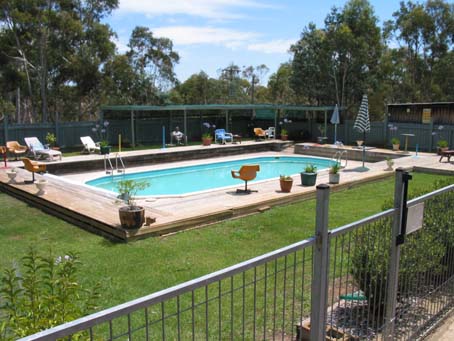
There are attractive walks to be found amongst the gnarled gum trees in and around the property and it's situated far enough from the major highway that noise is no real problem. It boasts a single-hole golf course, not dissimilar to the rattier parts of St. Andrew's and so not really in the running for the next Australian Open. However this golf course does have certain advantages which others don't. as you can see....
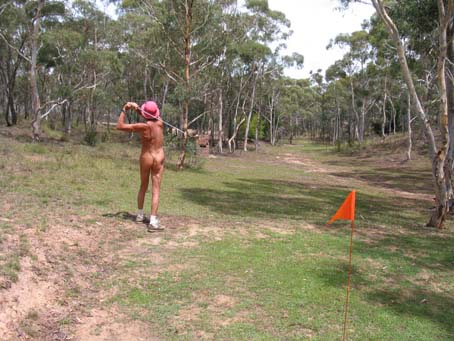
We had to pass through Canberra on our eventual departure south toward the Snowy River National Park. Unlike Sydney, Canberra is a delight to drive in or to pass through. A city designed from the bare ground up, you simply cannot get lost in it. The same can't altogether be said about the suburban sprawl which is beginning to surround the city. We didn't go through that portion where the disastrous fires of three years ago had destroyed so many homes. It was now Feb 1 and we headed toward the higher country of the Australian Alps.
The Australian Alpine Region is the home of the Snowy River Hydroelectric scheme, the only real hydro system in the country. Most of Australia's electric power comes from carbon fuel burning, high quality coal in Queensland, low quality (brown) coal in Victoria. This is because Australia simply doesn't have the water resources which, say, Canada or New Zealand have. We headed for Jindabyne, one of the centres for skiing in Oz, wherein every business seemed to be either accomodation for skiers or else equipment-hiring to skiers. From Jindabyne, most people take the so-called Alpine Way SW into the heart of Victoria. We elected to take the other, much less-travelled route, directly through the mountains of the Snowy River National Park to keep away from the trendy-touristy areas.
The road is described as 'unsealed, unsuitable for caravans [meaning trailers] and impassable in bad weather' all of which means 'gravelled roads, steep, twisty and with vertiginous edges'. All of this is true, we found, but the route is nonetheless much to be preferred if you want great scenery, quiet camp sites and little or no traffic. For the next couple of days we saw barely a dozen other vehicles and those mostly for Park maintenance. There was a lot of low cloud but it never seriously rained. We had wanted to take this route on our last visit but the sudden bush fires had scotched that project and we certainly saw the effect of these fires as we passed over the hills - great tracts of forest had been burned out, clearly visible even though the recovery was well under way. Unlike northern forests, the Australian trees, particularly gum trees, quickly re-establish themselves and very often the individual trees will survive all but the most severe fires. The black burned trunks are a familiar feature of the Australian landscape.The next few pictures show the steep road winding through the hills and valleys and what only a couple of years ago must have been a totally-blackened landscape.
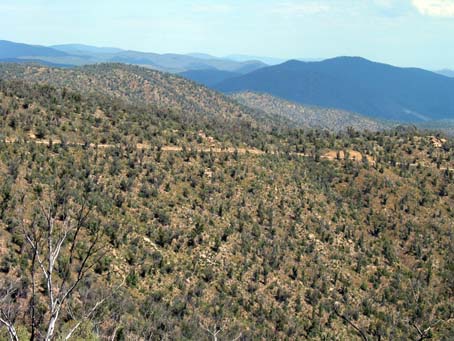
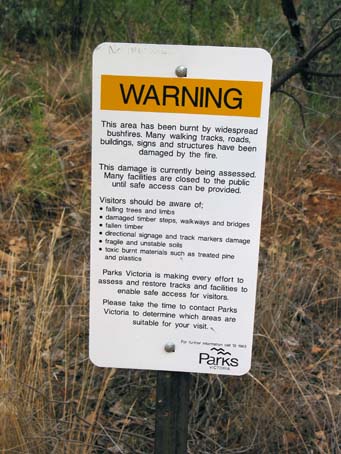
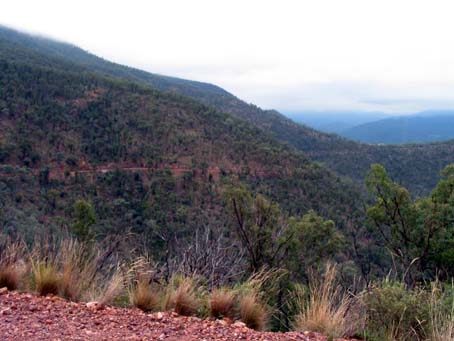
Note, please, at the bottom of the picture - that's the unprotected edge of the road. Nothing else for 200 m.
We followed the course of the Snowy River itself for much of the time, but usually high above it, occasionally descending down into the river valley itself, not often though, because the river is of course subject to flash floods and washouts would invariably occur. This is a magnificent park by the way, accessible enough and provided with many camping sites, mostly free.
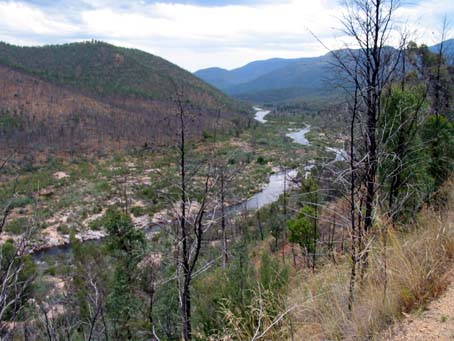
This is the edge of the road again - no safety rails anywhere !
We stopped at Pinch River, about halfway along the route - the quietest camp site so far, provided with every convenience (except a shower, but, then, we have a hot shower on board !). Included was a beautiful swim pool with a sandy bottom. But there were dozens of similar places we could have chosen.
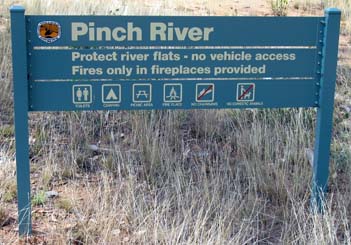
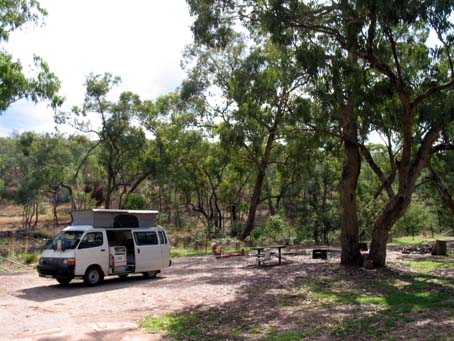
Next day, we completed our journey through the Snowy River Park, eventually descending slowly down through misty meadowlands via Suggan Buggan and Seldom Seen Roadhouse, finally meeting up with another Highway #1. This was the high speed route W. toward Melbourne where we had an appointment in a couple of days. We stopped for a night at Warragul, which has nothing to recommend it other than a post office where we could arm ourselves with a Toll Pass for the horrendous Melbourne road system. The toll roads in Melbourne are essential if you don't want to take five hours to cross the city - local drivers use an electronic device, installed to signal the toll charges. Alternatively, visitors can purchase limited time tickets, 24 hours, weekends etc and these are activated when first used. If you don't have these options then you can pay within a limited time else will have a hefty fine to teach you better manners....Oh, and here's a tip for would-be RV or campervan or campertrailer users in Australia - it appears that you can stop at the very frequent "rest stops" along highways here or even at their frequent gravel depots, for the most part overnight. Technically, you may not camp but provided you don't set up a tent or a trailer awning or put out a picnic table or a chair then you are not "camping" but merely "resting" which entirely satisfies the Letter of the Law. Would that the same were true in Canada, where the "rest stop" has become practically unknown along our highways - why ? because a business-oriented economy demands that motel and commercial campground monopoly be established once and for all time ! Tell your local MP all about it. And much good will it do you. OK, I will get off that particular soap box. Here's another soap box though - Australian roads are seldom contaminated by those atrocious billboards and tacky signs nailed onto trees. Think about it.
We made it to Tullamarine Airport in Melbourne with just a few minutes to spare, picked up Pat and George and then headed N. the 100 km. or so to Kyneton where we'll be staying for the next couple of weeks. First impressions - this is not a great resort as they go but it'll do for the time we will be here - we live in one of a couple of dozen self-contained villas set, not very creatfully, in a patch of contrived bushland. Accommodation is motel-style and we have a two-bedroom full-kitchen unit with access to an over-heated swimming pool, a tiny lake with some plastic 'Indian' canoes and a whole army of kangaroos and opossums who poop all over our petanque field. We tend to go out for short daily expeditions.
One such expedition was to the little town of Daylesford. This was simply to visit the weekly Saturday Market. The Market is a sort of way of life in rural Australia. Nominally a means of getting locally-grown produce from small farmers, it's become an extended garage sale where you can collect overpriced junk from hopefully-eager sellers of the same. There's always the chance that you'll find exactly the kind of wotsit which will fix up the doodad that's been sitting at the back of the garage for twenty years. And, hey, guess what ? I located exactly the 12 V. water-pump that has been plaguing us on Triton for the past few years. Couldn't resist such a bargain at $5. But I passed over the adzes, the slabs of beautiful mulga wood, the collections of 1950s vinyl and the drovers' oilskin riding coats etc etc which would have filled our minuscule luggage allowance twice over......

In the background of this market scene you'll see the railroad cars of the little broad-gauge line which has been lovingly preserved by the townsfolk. The motor rail cars still run on weekends at hourly intervals the 10 km or so of track which winds its way through the twisty and often steeply-graded route through farmlands and gum forests - the track as uneven and quite as bumpy as the memorable narrow-gauge track which until fairly recent times was virtually the only way to get into Alice Springs at certain times of the year. We went for a ride to the end of the line, ending up at Bullarto. Anyone who is familiar with the Australian habit of adding an 'o' to the end of words (as in 'servo' for 'service station') might be forgiven for thinking that 'Bullarto' is a tongue-in-cheek name. But that isn't so, assured our engine driver.
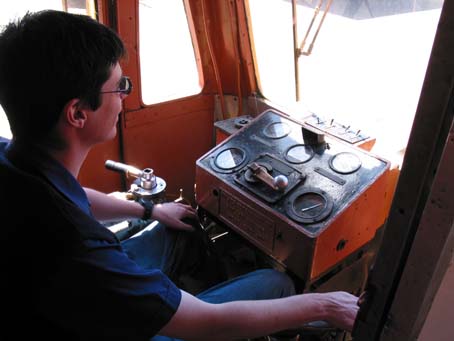
And here's an idea of the line twisting its way among the trees and frequent blackberry patches. Blackberries are considered a pest here (just as they are in parts of BC) because they spread like, well, bushfires. They're tough to eradicate and the thorns are nasty in the extreme. Of course, if you love blackberry pie as much as Enid Blyton and I do, then all that is irrelevant.
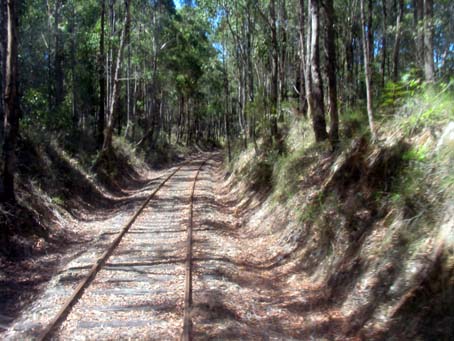
This country was opened up to a considerable extent up by the gold prospectors but it was the farmers who settled the land in a stable group - it's at quite a high altitude and gets chilly in the souther winters. Nevertheless there are many vineyards and olive plantations hereabouts, often struggling now because of the extended droughts of the past few years. Here's a view from the railway of one of the olive plantations - contrasting with the northern hemisphere, olives are on the S. side, grapes on the N. I wasn't aware that olives require a lot of post-harvest treatment to make them edible and ready for sale and this needs a lot of fresh water, not necessarily available by sinking a well or bore.These particular olive trees don't appear to be doing well.

We've made a visit to Bendigo, the large, very prosperous city 60 km N. of here. Bendigo is rich because of its gold. The ground beneath the city itself is honeycombed with shafts and workings, often more than a thousand feet deep, exploiting three major reefs. A lot of these shafts and drifts were considered worked out but as always, the price of gold determines what is meant by 'worked out:' and Bendigo remains a major gold source. If you have $100 million or so to invest in this goldfield then you, too, could be a part of its high-tech rejuvenation. On the other hand, you might still be able to pick up a gold nugget or two for free by wandering around with a metal detector. We looked at an early primitive digging for alluvial gold where the prospectors had very cleverly blasted a tunnel as a blowhole through a short rock barrier so as to retain and control the water for gravel-washing. No gold there now, if there ever was any, but the water flow remains and makes a very pleasant swimming pool, accessible via the tunnel through the rock face....
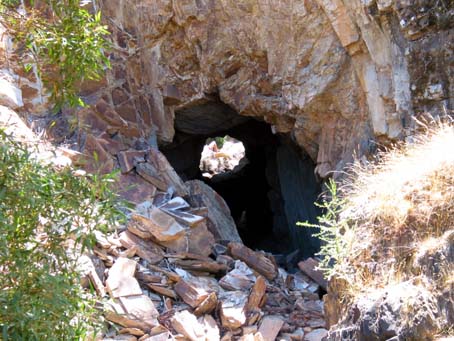
In the later nineteenth and earlier twentieth centuries very many Chinese came to Australia as gold diggers. They were subject to the extreme xenophobia of those times (not altogether absent at the present) and were harshly treated, usually as labourers in the diggings. For example, a poll tax of ten pounds per head was imposed for Chinese immigrants at the closer ports and so they very often landed elsewhere and walked a considerable distance, often more than 250 km, to avoid this crippling tax. A significant part of Bendigo's population is of chinese origin and they have preserved their heritage very carefully. The Chinese, by the way, were assuredly smart enough to realise that digging for gold was no way to make a fortune. On the other hand, if you care to set up a service industry for the gambling white diggers, then you can usually do much better than those guys afflicted with the gambling gold-fever. So they set themselves up as gardeners, cooks, launderers and, er, the other occupations and often did very well indeed, despite the discriminatory legislature of the times. There's a great Chinese museum in Bendigo (which has the world's biggest dragon, by the way) and attached to it is a delightful little Chinese garden.

A buddhist temple is next door with some fine porcelain tilings and wall paintings. There we burned some incense - one is supposed to leave a food offering also and I do hope that lemon sherbert candies ('lollies' in Australia), all I had, are acceptable.
The best mode of transport in Bendigo is the rail tram. This is an anachronism perhaps, but it gets you conveniently along the city's main streets and a ticket lasts for two days. The trams use the standard overhead rail, single phase 600 V at 40 A. peak and are being collected from other cities as they're being pahsed out. Here's one of the tram depots where the machinery is being restored as part of the states's dole work program. One of the other depots, by the way, is at the city's coal gas plant, not used any more of course but still intact if you want to see yet another anachronism.
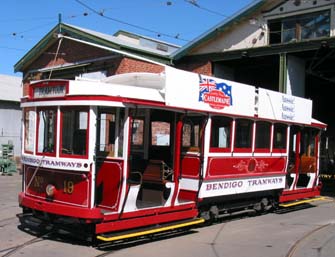
Finally, another witness to Bendigo's prosperity is the sheer size of its Cathedral of the Sacred Heart. Built in the early 1800s in English Gothic style, it's the largest in the southern hemisphere and stands, surmounted by its two-ton bronze cross, dominating the city centre which is unfortunately cluttered with the usual array of war memorials, Queen Victoria and other marble stuff. I don't know if that spire contains a peal of bells - it would seem a great pity if it doesn't - but maybe Roman Catholic Cathedrals don't go in for change ringing.
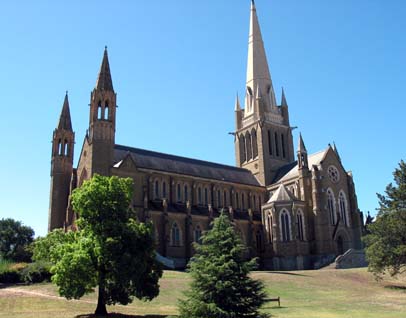
We'll be taking a few more short trips around this part of Victoria over the next ten days and then will probably head into the Dandenong Hills, a few km NE Melbourne. No sweat, mates.